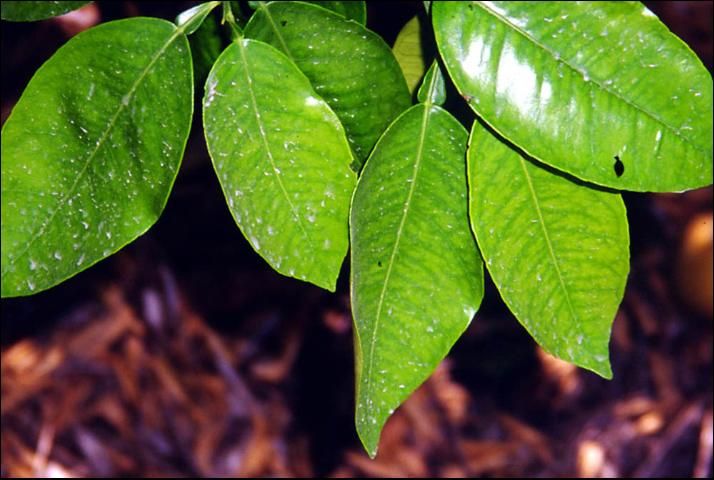Introduction
Citrus problems such as disorders, pest and disease damage, and nutritional deficiencies are numerous. The landscaper and homeowner should recognize visual symptoms of most common problems so that they take the proper action to minimize their negative impact on fruit production and fruit quality of citrus trees in their care. This publication is targeted to help the landscaper and homeowner identify some problems occurring on their citrus trees. It should also help them understand the probable causes, precautions, and cultural practices needed to alleviate or solve those problems.
The landscaper and homeowner should be aware that uniform and adequate soil moisture is important to reduce several problems and disorders. Maintenance of good fertility programs and planting trees in high areas where water and air drainage are good, and on soils with optimum pH are also important to reduce diseases, nutritional imbalances and deficiencies. Pest monitoring and timely scheduling of spray applications can be critical in minimizing blemishes and reducing fruit drop. Trees should be examined frequently for pests, diseases, and disorders which reduce the health and productivity of citrus trees. Whenever a spray application is needed, avoid spraying during dry hot windy conditions. Many disorders, blemishes, pests, diseases, and deficiencies have characteristic damage patterns, colors, or roughness that can be used for diagnostic purposes. However, the landscaper and homeowner should keep in mind that not all problems are easy to diagnose or require pesticide applications as the fruit is not intended for fresh fruit sales. There is a limit to what they can do and weather conditions can cause problems that may not be avoided.
Disorders
Dead Wood and Twig Dieback
The presence of a certain amount of dead wood is natural in the normal development of a citrus tree, and represents the tree's ability to maintain the appropriate shoot to root ratio (Figure 1). Selective pruning may reduce twig dieback in the interior of the tree canopy. Excessive twig dieback on the outside of tree canopies may result from a number of factors that cause defoliation including freezes, drought, severe pest pressure, declining diseases such as citrus tristeza virus, blight, water damage, greasy spot, spray burn, or other problems causing severe root damage or leaf drop.

Fruit Drop
In some cases, a combination of factors rather than a single factor may cause fruit drop (Figure 2), making an absolute diagnosis and remedy difficult. Whenever fruit is injured, the production of ethylene gas is triggered and the fruit may drop. In late summer to early fall, excessive fruit drop can occur on mature trees of early and mid-season cultivars planted in low-lying or poorly-drained areas due to epidemics of brown rot associated with extended wet periods and warm temperature. Excessive fruit drop from maturity until harvest in some years can exceed 25% of the crop. These losses seem to be more serious when hot rainy fall weather conditions prevail. Minimize water stress with a good water management program to reduce fruit losses. In some cases, drop is more associated with the lower, shaded areas of the tree canopy. Fruit drop can be aggravated by low potassium levels in heavy crop load years. Inadequate fruit set and severe fruit drop are major causes of low yield of navel orange. Fruit drop after fruit set has been mainly attributed to problems associated with the small, secondary fruit that is embedded in the primary fruit of Navel oranges. The June drop (usually 8-10 weeks after bloom) seems to result from competition between fruitlets and young leaves for carbohydrates, water, and other metabolites.
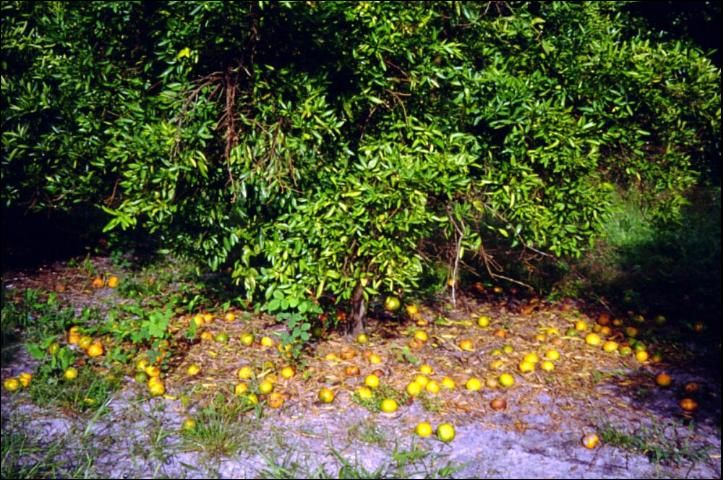
Sunburn
Fruit damage (Figure 3) may occur on fruit exposed for a long period of time to direct sunlight, most often on thin-skinned varieties, especially those trees bearing fruit that extend beyond the leaf canopy. The Murcott (Honey tangerine) is one of the most susceptible varieties to sunburn due to the tree growth habit. Sunburn causes the drying of the exposed portion of the peel, and the pulp and juice beneath it.

Fruit Splitting
Splitting (Figure 4) is more severe on some cultivars such as Valencia, Hamlin, Navel oranges, and Murcott. Grapefruit, Dancy tangerines, tangelos, and Temple fruit have a lower incidence of splitting. Fruit splitting is primarily a problem at high temperature during periods of high humidity and rainfall from August through the fall. The exact cause is unknown but is believed to be a problem of water relations and peel thickness. Damage often occurs when trees take up water from rain or irrigation after a long dry period and the fruit expands, bursting the peel in a crack across the bottom. Splitting incidence varies seasonally and is usually greatest where cropload is heavy. Splitting may result from water and/or nutritional stresses early in fruit development. Low to deficient potassium levels resulting in thin peel promotes fruit splitting. Proper tree nutrition and a good water management program are the best defense against fruit splitting.
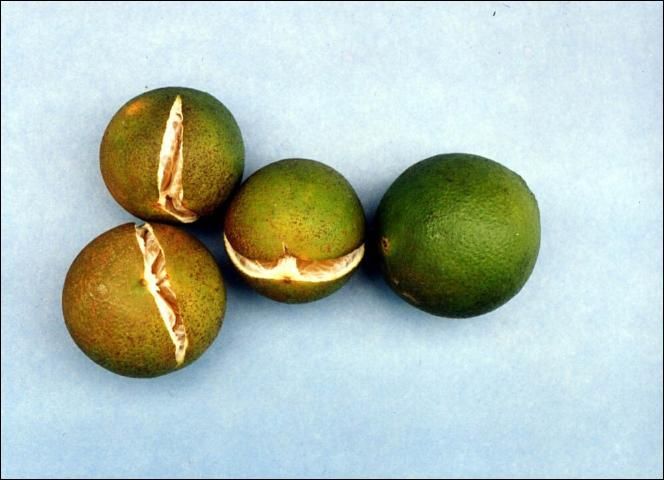
Premature Fruit Drying (granulation)
Navel, mandarins, mandarin hybrids, grapefruit and Valencia fruit sometimes exhibit drying of juice vesicles (Figure 5) when harvest is delayed or when the trees are grown on lemon or other vigorous rootstocks. The problem varies seasonally and is more of a problem on larger size or late bloom fruit. Drying appears to be associated with over-maturity, a lack of water, excessive tree vigor, extended warm, and/or dry fall weather. Premature fruit drying is also a problem associated with young trees, a condition that is alleviated with tree maturity.
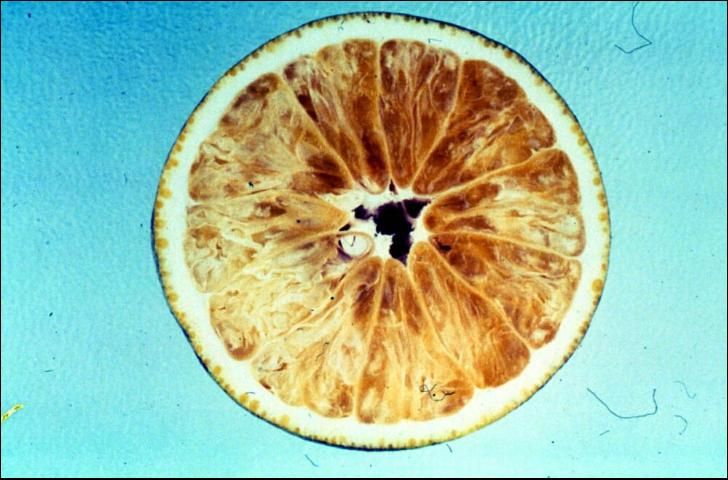
Yellow Vein Chlorosis
Yellow vein chlorosis (Figure 6) may be attributed to the girdling of individual branches, tree trunks, or roots due to a number of factors including water damage, Phytophthora foot rot, root rot, ant damage, or physical damage by equipment. Yellow vein chlorosis may also occur on twigs and branches due to cool weather in the fall and winter due to lack of nitrogen uptake from the soil. In leaves showing yellow vein chlorosis, the midribs and lateral veins and a narrow band of leaf tissue bordering them become yellow while the rest of the leaf remains green.
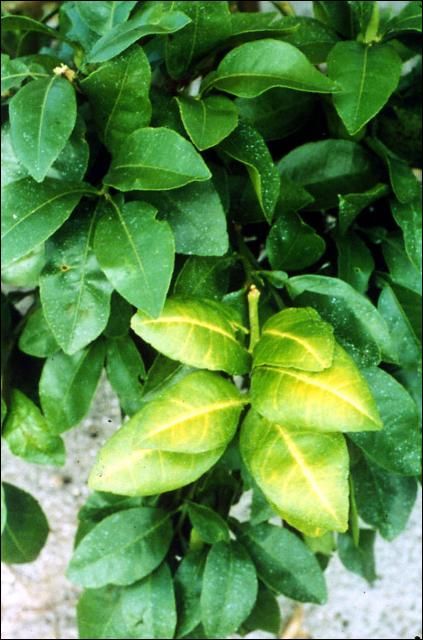
Diseases & Pests
Citrus Canker
Citrus canker, caused by a bacterial pathogen, is a serious disease of most citrus varieties. The disease causes necrotic lesions on leaves, stems, and fruit. Severe infestation can cause defoliation, premature fruit drop, twig dieback, general tree decline, and very bad blemishes on fruit. The earliest symptoms on leaves appear as slightly-raised, tiny, blister-like lesions. As the lesions age, they turn tan to brown and a wate- soaked margin appears surrounded by a yellow halo (Figure 7). The center of the lesion becomes raised and corky. Lesions are usually visible on both sides of the leaf. The lesions on the leaves sometimes fall out, leaving round holes. Defoliation becomes a problem as the disease intensifies on the tree. Symptoms of citrus canker on twigs and fruit are similar and consist of raised corky lesions surrounded by an oily or water-soaked margin. As the lesions on the fruit mature, they appear scab like or corky (Figure 8). Citrus canker is highly contagious and can be spread rapidly by wind-driven rain, lawnmowers, and human movement. Citrus canker can be controlled by copper fungicides.
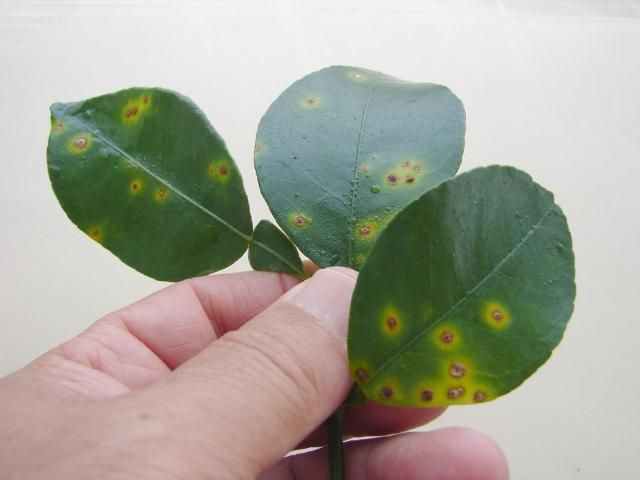
Credit: Mongi Zekri.
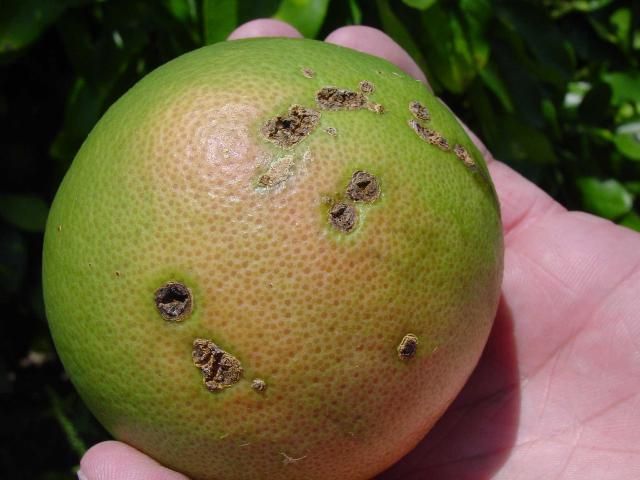
Credit: Mongi Zekri
Citrus Greening
Citrus greening is one of the most destructive diseases of citrus. Citrus greening is caused by systemic phloem-inhabiting bacterium. The bacterium infects nearly all citrus species, cultivars, and hybrids and some citrus relatives. The early symptoms usually appear on one sector or branch of the tree. Symptoms are characterized by yellowing of normal-sized leaves along the veins and sometimes by the development of a blotchy-mottle (Figure 9). The leaves are small, upright, and show a variety of chlorotic patterns resembling those induced by zinc and iron deficiencies. Infected trees or branches suffer heavy leaf drop followed by out-of-season flushing and flowering, with dieback occurring in severe cases. Infected fruit (Figure 10) are small, lopsided, with aborted seeds, and have a bitter taste and unpleasant flavor in the juice, probably because of higher acidity and lower sugars. Many fruit fall prematurely, while those remaining on the tree do not color properly. Affected trees decline to a non-productive state. Citrus greening bacteria are transmitted by the citrus psyllid. There is no cure for citrus greening, but good care of trees including irrigation, weed control, soil-applied fertilizer, foliar nutrition, and effective psyllid control may keep the trees productive.
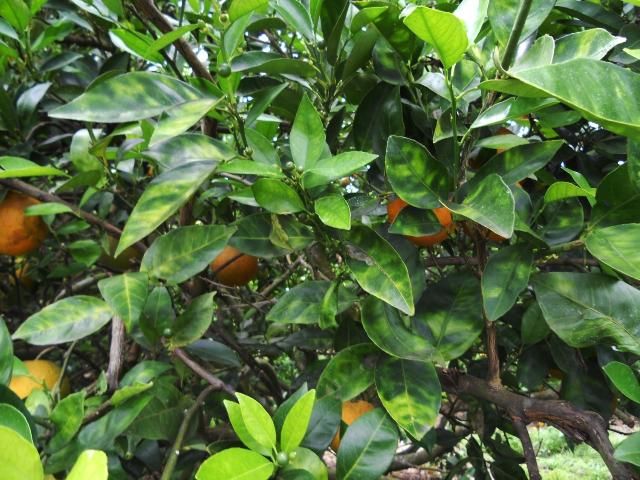
Credit: Mongi Zekri.
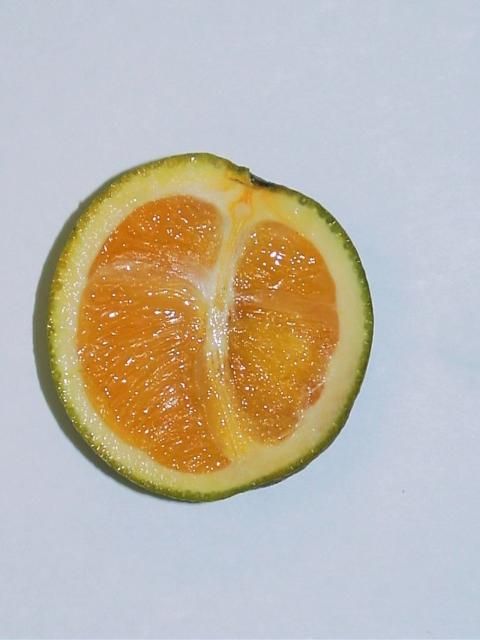
Credit: Mongi Zekri.
Alternaria Brown Spot
Alternaria brown spot infection of young shoots and leaves causes dieback and defoliation. Later infection of leaves produces discrete brown spots and/or large blotches surrounded by yellow areas (Figure 11). A useful diagnostic symptom of Alternaria brown spot is the blackening of leaf veins leading from dark lesions. Early infection of fruit causes slightly sunken black to dark brown spots with yellow color halos and fruit drop. The sunken areas become corky and fail to produce characteristic round pockmarks in fruit that continue to mature. This fungal disease can cause severe leaf and fruit drop particularly in Minneola (Honeybell) and Orlando tangelos, Dancy tangerine, and Murcott (Honey tangerine). Leaf tissue is susceptible until it is fully expanded and fruit is susceptible for about 3 months after bloom. Only disease-free trees should be planted. Trees should be spaced widely to promote rapid drying of the tree canopy. It is best to locate susceptible varieties in high areas where air drainage is good so that leaves dry more rapidly. Use copper fungicides to control this disease. The first spray should be applied when the spring flush leaves are 1/4 -1/2 expanded. The second spray should be applied when the leaves approach full expansion to reduce infection on the fruit. Another spray should be scheduled about 4 weeks later or shortly after petal fall. From April though June, spray applications may be needed as often as every 2-4 weeks depending on the frequency and amount of rainfall.
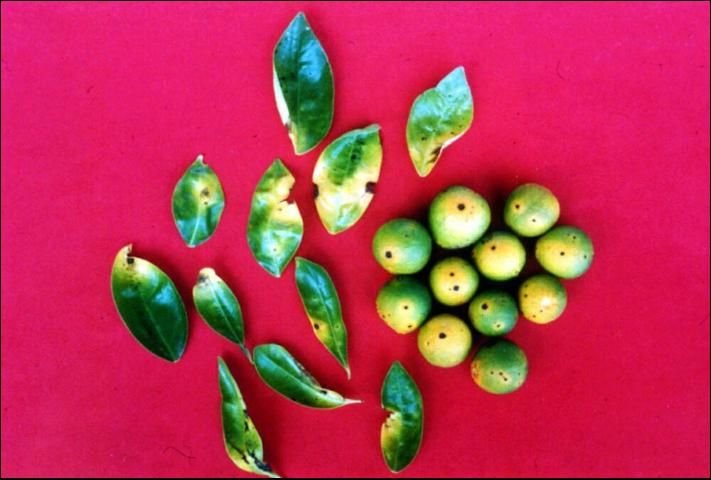
Citrus Scab
In citrus scab, corky outgrowths begin on leaves, shoots, and fruit as rounded pustules (Figure 12). Initially, scab lesions on fruit consist of slightly raised pink to light brown pustules. As these pustules develop, they become wart-like, cracked, turn yellowish brown, and eventually dark gray. The outgrowths may be so numerous on fruit that it becomes distorted. Lesions on grapefruit and certain oranges can be confused with wind scar because they tend to be flatter than those on lemons, Satsuma mandarins, Temples, and sour oranges. This fungal disease affects grapefruit, Temple orange, Murcott, tangelos, and some other tangerine hybrids. If leaves from the previous season are heavily infected by citrus scab, 3 applications of copper fungicides should be scheduled to control this disease. The first spray should be applied at about 1/4 expansion of the spring flush leaves, the second at petal fall, and the third about 3 weeks later. Fruit becomes resistant to scab about 2-3 months after petal fall. On tangelos and Murcott, Alternaria brown spot and scab occur together.
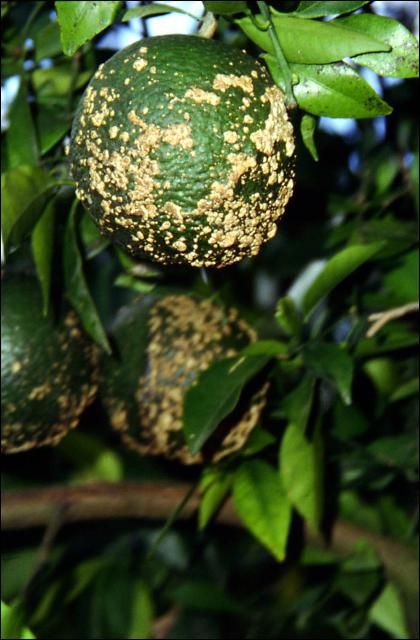
Greasy Spot
Greasy spot spores germinate on the underside of the leaves, penetrate the leaf tissue, and cause cellular swelling resulting in blister formation on the lower leaf surface (Figure 13). Yellow spots first appear on the upper leaf surface, then irregular brown blisters that become dark, slightly raised, and have a greasy appearance develop on lower, and later, upper leaf surfaces. Leaf drop may occur even before full leaf symptoms develop. Defoliation decreases fruit production, and makes the tree more susceptible to cold damage and attack by other pests. Visible symptoms do not generally appear on Valencia leaves before January. On more susceptible cultivars, such as grapefruit, symptoms may become evident by October. Management of greasy spot must be considered for every citrus tree. Greasy spot is usually more severe on grapefruit, Pineapple, and Hamlin oranges, and tangelos than Valencia, Temple, Murcott, tangerines, and tangerine hybrids. Favorable conditions for infection in southwest Florida occur from late May through September. Leaves are susceptible once they are fully expanded and remain susceptible throughout their life. Two sprays are needed to control greasy spot in southwest Florida. The first spray should be scheduled in May-June and the second in July–August. Thorough coverage of the underside of leaves with copper fungicides plus oil is important and necessary for the control of greasy spot.
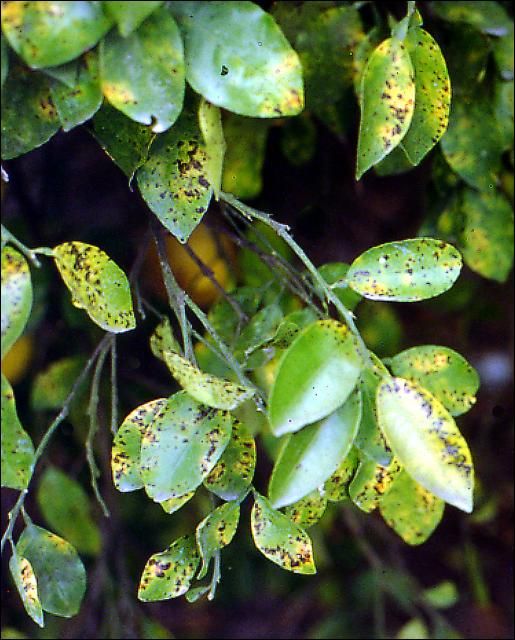
Phytophthora
Phytophthora (Figure 14) is a soil-borne disease. Its symptoms include sloughing off of roots (root rot) and bark peeling in crown roots and trunk at the soil level (foot rot). Reddish brown resin may exude from above ground infection areas. Partial or complete girdling of the trunk with abundant wound tissue often occurs, leading to tree decline with yellow vein chlorosis of leaves, leaf drop, fruit drop, dieback, and death. When wet areas are considered for planting, drainage must be improved prior to planting citrus trees to minimize potential foot and root rot problems. Trees should be planted at the correct depth with the budunion well above the soil surface. Trees should not be wrapped or mulched. Irrigation should be scheduled in the morning to reduce prolonged bark wetness and the area under the tree canopy should be kept free of grass and weeds.
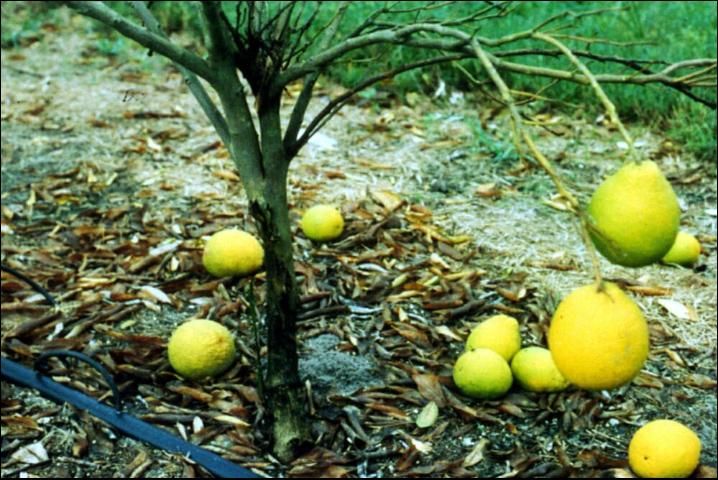
Sooty Mold
Sooty mold is the result of massive, superficial fungal growth most commonly occurring on leaves, fruit, twigs, and small branches (Figure 15). Sooty mold is a black thin mat usually caused by a fungus that grows on the sugary excrement (honeydew) of insects with piercing-sucking mouth parts such as whiteflies, scales, aphids, and mealybugs. When abundant, sooty mold can reduce photosynthesis and delay fruit coloring. Sooty mold represents a dramatic sign that insect populations have reached damaging levels. Its control involves reduction of insects causing honeydew buildup. Applications of oil will loosen sooty mold and help control insects if present.
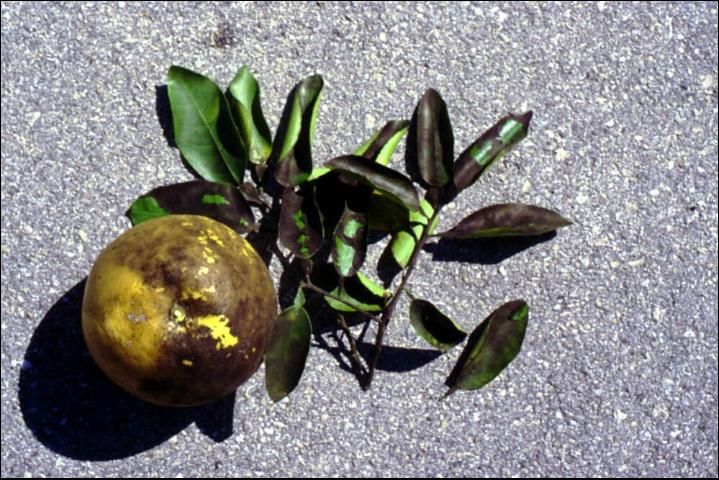
Aphids
Aphids (Figure 16) are closely associated with new growth flushes and newly, emergent, succulent leaves. Aphids can be light green-yellow, grey-green, brown, or black. The brown citrus aphid is the most effective vector for the citrus tristeza virus. Aphids are quite small (less than 2 mm). Colonies can be composed of wingless and winged forms. Rapid population growth is initiated with the spring flush. Heavy populations of aphids can also be noticeable on early summer flushes. Infestations and sustained feeding result in distorted growth and stunting followed by leaf cupping and curling or twisting. Aphids are more damaging to young trees. Honeydew caused by aphids can be observed on infested flush, and sooty mold fungi may build up around the infestation. Among the natural enemies of aphids is the ladybird beetle or ladybug.
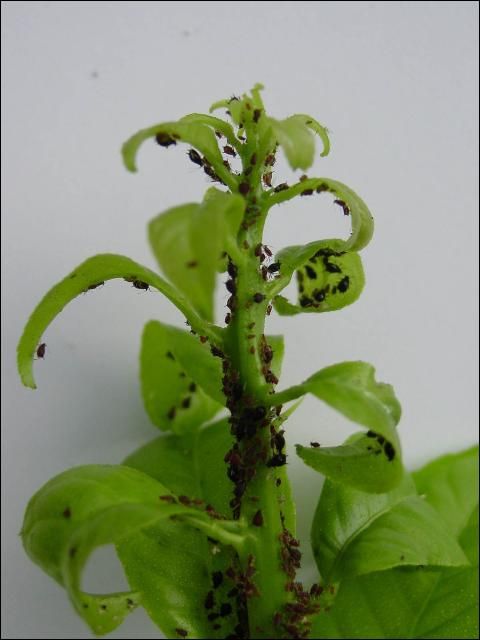
Citrus Leafminer
The hatching citrus leafminer larvae enter the leaf tissue and begin feeding beneath the epidermal (surface layer) cells. The larvae create mines in the leaf (Figure 17). The mines enlarge as the leafminer develops. Symptoms of infestation include curling of leaves and serpentine mines on the lower and upper sides of leaves. The epidermis appears as a silvery film over leaf mines. Citrus leafminer can occur on new flush throughout the growing season, but usually does not affect the first spring flush due to low over-wintering populations. Citrus leafminer generally does not noticeably affect growth and yield of mature trees. Biological control through natural enemies already present in Florida and the introduced parasitoid wasp makes a significant contribution in suppressing the problem. However, young trees are vulnerable to severe leafminer damage because of frequent leaf flushes.
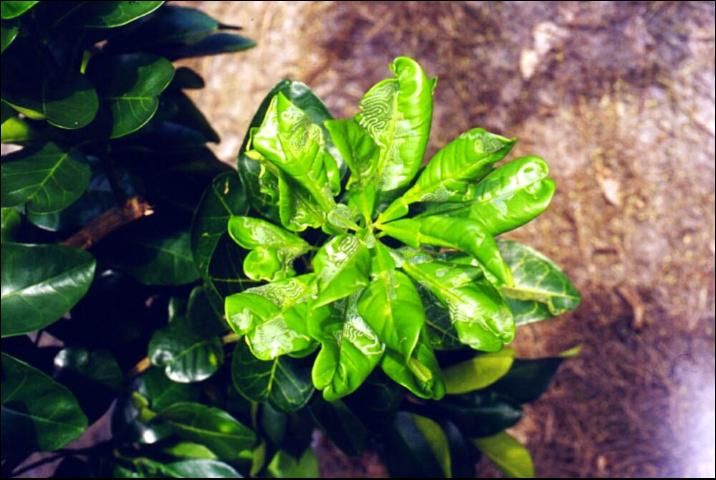
The Citrus Psyllid
High populations of the Asian citrus psyllid cause feeding damage because they attack young tender growth (flush), causing leaf distortion and curling (Figure 18). The psyllid also produces honeydew, which leads to sooty mold infestations, and badly-damaged leaves will die and fall off. Feeding by the citrus psyllid on the young flush of citrus trees causes damage to leaves and shoots because the psyllid has a toxic saliva. The citrus psyllid breeds exclusively on young flush and has a very high reproductive rate. Multiple, overlapping generations can lead to very high populations. Oil sprays can provide good control if applied frequently. Oil has a number of advantages over conventional pesticides because it is less disruptive to natural enemies, insects do not develop resistance to it, it has a low toxicity to vertebrates, and it breaks down readily in the environment.
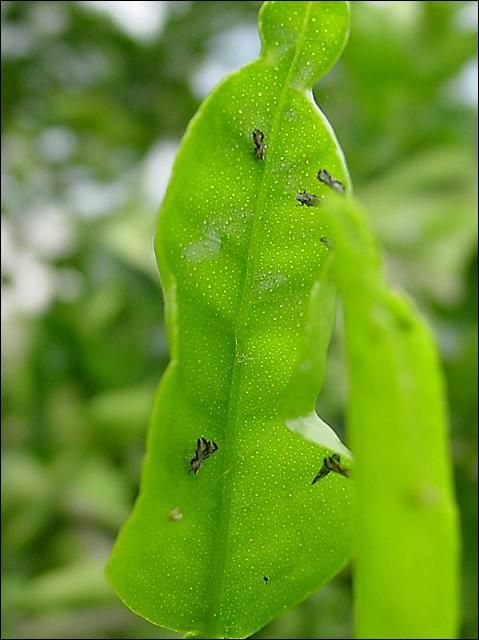
Citrus Rust Mite
When rust mite injury occurs on young fruit before fruit maturity, epidermal cells are destroyed resulting in smaller fruit (Figure 19). Later, epidermal cells become brownish-black and rusty looking. Citrus rust mites may be found on all citrus cultivars throughout Florida. On some cultivars such as Sunburst, Fallglo, and Ambersweet, rust mite damage can be severe on stems and foliage and may cause leaf drop. Mite populations usually begin to increase in April on new foliage and reach a peak in June–July. Depending on weather conditions and the occurrence of natural enemies, citrus rust mite populations usually decline in August and September, but increase again in October and November. Oil should be effective in suppressing rust mites.
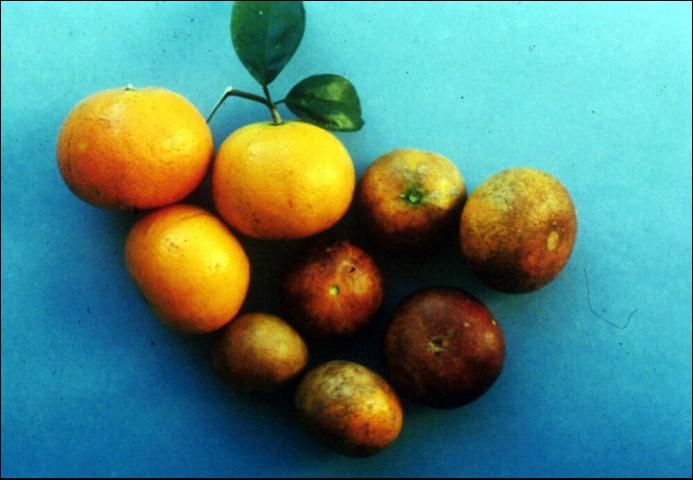
Nutritional Deficiencies
At least sixteen elements are considered necessary for the growth of plants and trees: carbon (C), hydrogen (H), oxygen (O), nitrogen (N), phosphorus (P), potassium (K), calcium (Ca), magnesium (Mg), sulfur (S), iron (Fe), zinc (Zn), manganese (Mn), boron (B), copper (Cu), molybdenum (Mo), and chlorine (Cl). Plants obtain O, H, and C from water, carbon dioxide from the atmosphere, and the other nutrients from the soil. Visual deficiency symptoms of N, Mg, Fe, Zn, and Mn are quite definite and can usually be recognized by distinctive symptoms most often occurring on leaves.
Nitrogen (N) Deficiency
Nitrogen deficiency first appears on older leaves. Nitrogen deficiency symptoms are characterized by light yellowish-green leaves (Figure 20). The veins are only slightly lighter in color than the tissues between. New leaves are reduced in size, thin, and light-green in color. Leaves on new flushes are greener than leaves on old flushes. Mature green leaves slowly bleach to a mottled irregular green and yellow pattern and become entirely yellow and fall from the tree. The trees have a thin canopy, are stunted, and the crop is reduced. It must always be remembered that yellow leaves are not necessarily an indication of N deficiency. For bearing citrus trees, there should be adequate N in the trees just before flower initiation and at the time of flowering and fruit set. There also should be enough N for fruit development. For young trees, adequate N should be supplied throughout the year to promote continuous rapid vegetative growth.
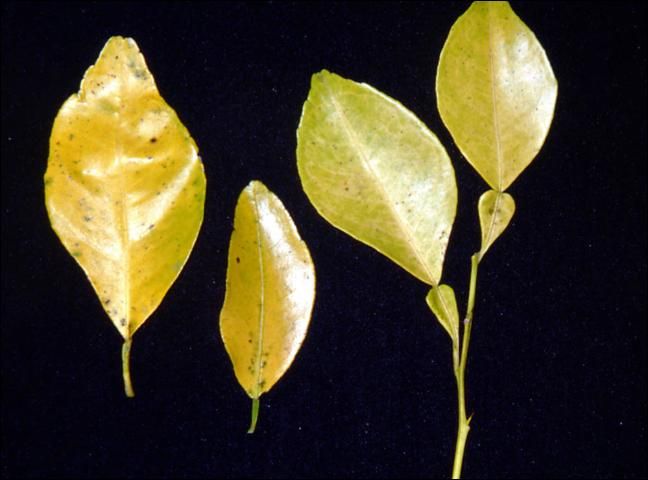
Magnesium (Mg) Deficiency
In magnesium (Mg) deficiency, disconnected yellow areas or irregular yellow blotches start near the base along the midribs of mature leaves that are close to fruit (Figure 21). They become gradually larger and eventually coalesce to form a large area of yellow tissue on each side of the midrib. This yellow area enlarges until only the tip and the base of the leaf are green showing an inverted V-shaped area pointed on the midrib. In acute deficiency, the yellow area may gradually enlarge until the entire leaf becomes yellow or bronze in color. Leaves that have lost most of their green color drop freely in unfavorable conditions such as cold weather or water stress. Defoliated twigs are weak and usually die by the following spring. If the soil pH is below 5, the use of dolomite to increase the pH to 6.0-6.5 will furnish Mg at the same time. Soil application of Epsom salt (magnesium sulfate) or magnesium oxide can be successful in correcting Mg deficiency when the soil pH is adjusted. Foliar spray of Mg nitrate can be effective when applied on the spring flush leaves when they are two-thirds to fully expanded but not hardened off.

Iron (Fe) Deficiency
Iron deficiency (Figure 22) is mainly a problem on calcareous soils. It is also associated with over irrigation, prolonged spells of wet soil conditions or poor drainage, and low soil temperature. The symptoms of Fe deficiency have been known as "iron chlorosis". Iron deficiency symptoms occur on new growing leaves that are very light in color and sometimes almost white but with the veins greener than the remainder of the leaf. In acute cases, the leaves are reduced in size, very thin, and shed early. The most reliable means of correcting Fe chlorosis is by soil application of iron chelates such as Sequestrene 138 Fe.
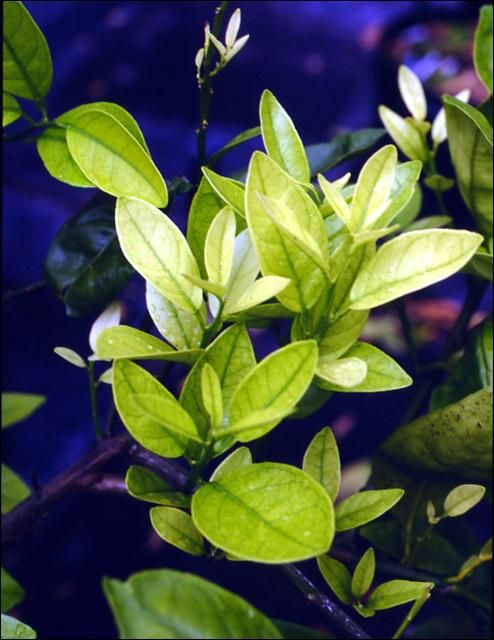
Zinc (Zn) Deficiency
Zinc deficiency symptoms are characterized by irregular green bands along the midrib and main veins on a background of light yellow to almost white (Figure 23). The relative amounts of green and yellow tissue vary from a mild Zn deficiency in which there are only small yellow splotches between the larger lateral veins to a condition in which only a basal portion of the midrib is green and the remainder of the leaf is light yellow to white.
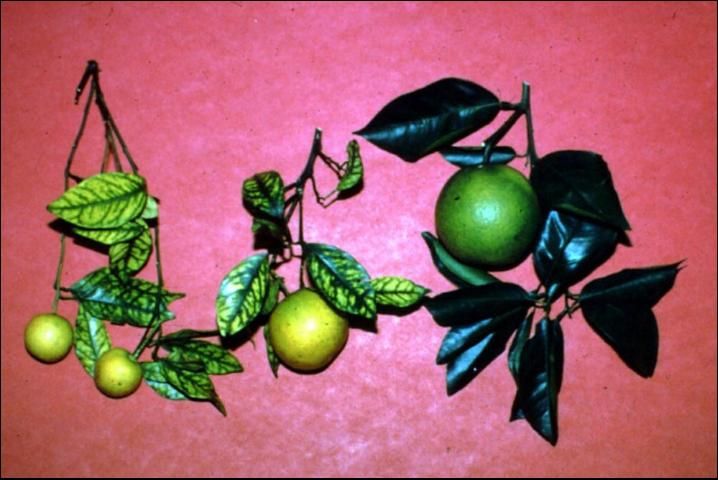
In less acute stages, the leaves are almost normal in size, while in severe cases the leaves are pointed, abnormally narrow with the tendency to stand upright, and extremely reduced in size. Fruit are drastically reduced in size and have an unusually smooth, light-colored, thin skin and very low juice content. Foliar spray of solutions from Zn sulfate, oxide, or nitrate can correct Zn deficiency. Maximum benefit is obtained if spray is applied to the young growth when it is two-thirds to nearly fully expanded and before it hardens off. Zinc application to the spring flush is preferable.
Manganese (Mn) Deficiency
Manganese deficiency (Figure 24) is particularly evident in the spring after a cold winter. Sometimes the deficiency can be confused with deficiency symptoms of Fe and Zn. Manganese deficiency leads to a chlorosis in the interveinal tissue of leaves but the veins remain dark green. Young leaves commonly show a fine pattern or network of green veins on a lighter green background but the pattern is not so distinct as in Zn or Fe deficiencies because the leaf is greener. By the time the leaves reach full size, the pattern becomes distinct as a band of green along the midrib and principal lateral veins with light green areas between the veins. The leaves are not reduced in size or changed in shape by Mn deficiency. Manganese deficiency is frequently associated with Zn deficiency. For deficient trees, treatments by sprays of Mn compounds are recommended. Foliar spray application quickly clears up the pattern on young leaves but older leaves respond less rapidly and less completely. Foliar spray of a solution containing Mn on two-third to fully expanded spring flush leaves is recommended.
